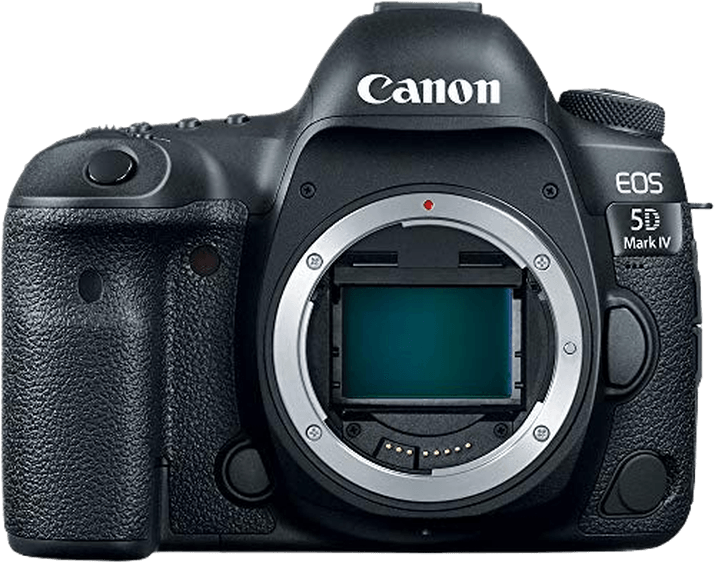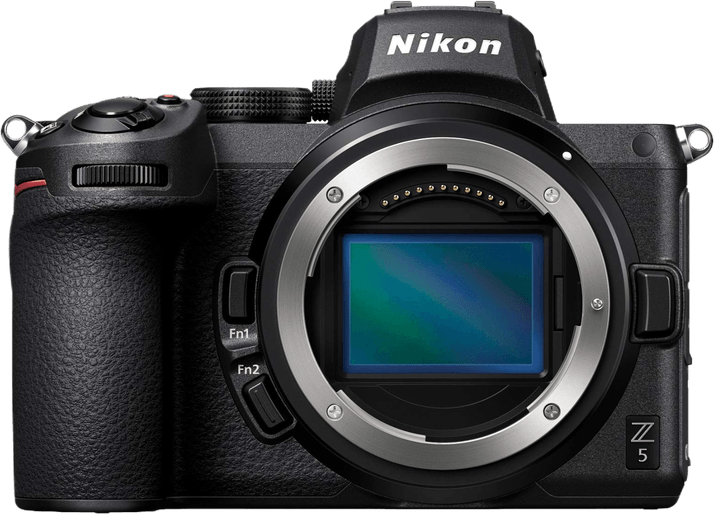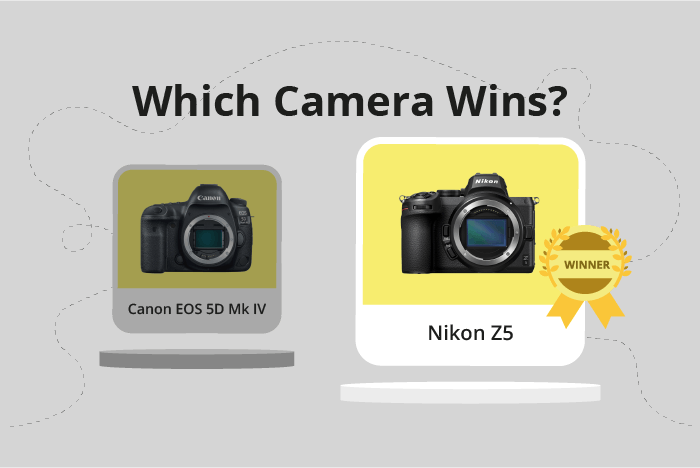Canon EOS 5D Mark IV vs Nikon Z5 Comparison
Canon EOS 5D Mark IV

Nikon Z5

The Nikon Z5 wins by a narrow margin, scoring 78/100 compared to the Canon EOS 5D Mark IV‘s 75/100. Both cameras share similarities, such as being released in the 2016-2020 timeframe and having a launch price of over $1000.
The Nikon Z5 outperforms the Canon EOS 5D Mark IV in terms of weight and size, being lighter at 675g and having smaller dimensions (134 x 100.5 x 69.5mm). This makes the Nikon Z5 a more portable option for photographers. The Canon EOS 5D Mark IV, however, has its advantages, such as being a DSLR, which some photographers prefer over mirrorless cameras like the Nikon Z5.
Taking these factors into account, the Nikon Z5 is a better camera for those seeking a lightweight and compact option, while the Canon EOS 5D Mark IV caters to those who prefer DSLR cameras.
Canon EOS 5D Mark IV vs Nikon Z5 Overview and Optics
The Nikon Z5 outperforms the Canon EOS 5D Mark IV in optics, scoring 81/100 compared to the Canon’s 76/100. Both cameras share some specifications, such as having a CMOS sensor, full-frame sensor size, and respective lens mounts (Nikon Z for the Z5 and Canon EF for the 5D Mark IV). However, the Nikon Z5 surpasses the Canon in certain aspects, contributing to its higher score.
The Nikon Z5’s superiority is evident in its DXOMARK sensor score of 97, compared to the Canon’s 91. This difference suggests improved image quality and better low-light performance. Additionally, the Nikon Z5 features image stabilization, providing steadier shots and improved handheld photography. The Canon 5D Mark IV lacks this feature, making it less versatile in challenging shooting conditions.
Despite the lower score, the Canon EOS 5D Mark IV excels in other areas. It boasts a higher megapixel count of 30.4, compared to the Nikon Z5’s 24, allowing for more detailed images and better cropping flexibility. Furthermore, the Canon has a faster shooting speed of 7 frames per second, compared to the Z5’s 4.5, making it more suitable for capturing fast-moving subjects and action photography.
While the Nikon Z5 proves to be the better choice in terms of optics, the Canon EOS 5D Mark IV has its advantages in resolution and shooting speed. Ultimately, photographers should consider their specific needs and preferences in choosing between these two cameras.
Canon EOS 5D Mark IV vs Nikon Z5 Video Performance
The Canon EOS 5D Mark IV outperforms the Nikon Z5 in terms of video capabilities, scoring 91 out of 100 compared to the Nikon Z5’s score of 83. Both cameras share some common specifications, such as 4K max video resolution and built-in time-lapse functionality. However, there are key differences that make the Canon EOS 5D Mark IV a better choice for video recording.
One significant advantage of the Canon EOS 5D Mark IV is its higher max video dimensions of 4096 x 2160, compared to the Nikon Z5’s 3840 x 2160. This difference allows the Canon EOS 5D Mark IV to capture more detailed and higher quality videos. Additionally, the Canon EOS 5D Mark IV has a higher max video frame rate of 120fps, which is double the Nikon Z5’s 60fps. This higher frame rate enables the Canon EOS 5D Mark IV to record smoother slow-motion footage and provides more flexibility in post-production.
On the other hand, the Nikon Z5 does not have any significant advantages over the Canon EOS 5D Mark IV in the video department. Both cameras have the same 4K max video resolution and built-in time-lapse functionality, but the Nikon Z5 falls short in other areas, as mentioned above.
In comparing the two cameras, the Canon EOS 5D Mark IV is the clear winner for video capabilities due to its higher max video dimensions and frame rate. While the Nikon Z5 is still a capable camera, those looking for superior video performance should opt for the Canon EOS 5D Mark IV.
Canon EOS 5D Mark IV vs Nikon Z5 Features and Benefits
The Canon EOS 5D Mark IV wins in the feature comparison with a score of 74/100, while the Nikon Z5 scores 72/100. Both cameras share some common specifications, such as a 3.2-inch screen size and touchscreen capability. They also both have WiFi connectivity, allowing for easy transfer of images and remote control of the camera.
The Canon 5D Mark IV outperforms the Nikon Z5 in screen resolution, boasting 1,620,000 dots compared to the Z5’s 1,040,000 dots. This higher resolution results in a clearer and sharper display, making it easier for photographers to review their images and make adjustments. Additionally, the 5D Mark IV has GPS functionality, which the Z5 lacks. This feature enables photographers to geotag their images, providing valuable information about the location where the photos were taken.
On the other hand, the Nikon Z5 offers a flip screen, which the Canon 5D Mark IV does not have. This feature is useful for shooting at different angles and for capturing self-portraits. Furthermore, the Z5 has Bluetooth connectivity, allowing for seamless pairing with other devices and additional remote control options.
In terms of features, the Canon EOS 5D Mark IV edges out the Nikon Z5 due to its superior screen resolution and the addition of GPS functionality. However, the Nikon Z5 holds its own with the inclusion of a flip screen and Bluetooth connectivity. Photographers should weigh the importance of these features when deciding between the two cameras, considering their specific needs and preferences.
Canon EOS 5D Mark IV vs Nikon Z5 Storage and Battery
The Nikon Z5 wins the storage and battery comparison with a score of 73/100, while the Canon EOS 5D Mark IV scores 71/100. Both cameras have two memory card slots and accept SD, SDHC, and SDXC cards. The Nikon Z5 is compatible with UHS-II cards, offering faster read and write speeds than the Canon EOS 5D Mark IV’s UHS-I compatibility.
The Canon EOS 5D Mark IV, however, has a longer battery life of 900 shots compared to the Nikon Z5’s 470 shots. The Canon also uses an LP-E6N battery, while the Nikon uses an EN-EL15c battery. Despite the shorter battery life, the Nikon Z5 has the advantage of USB charging, which the Canon EOS 5D Mark IV lacks.
Taking these factors into account, the Nikon Z5 offers better storage options with its UHS-II compatibility and USB charging, while the Canon EOS 5D Mark IV provides longer battery life. Both cameras have their strengths and weaknesses, but the Nikon Z5 edges out the Canon EOS 5D Mark IV in this comparison.
Canon EOS 5D Mark IV vs Nikon Z5 – Our Verdict
Are you still undecided about which camera is right for you? Have a look at these popular comparisons that feature the Canon EOS 5D Mark IV or the Nikon Z5:

